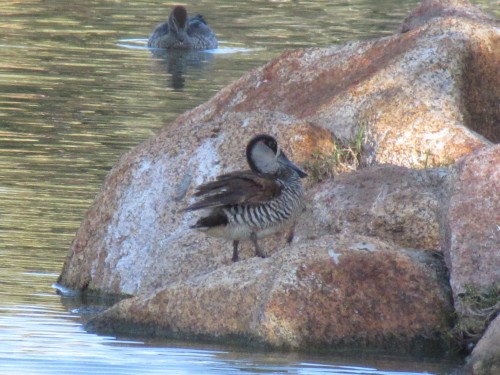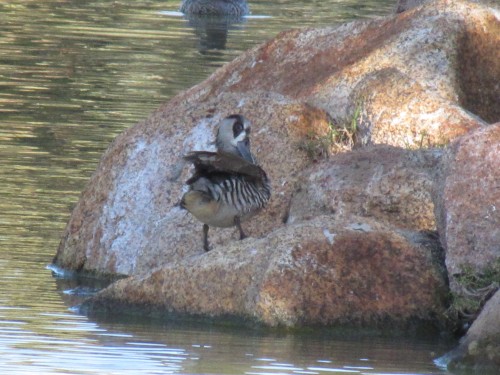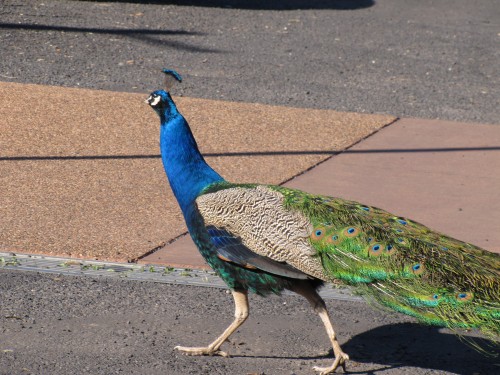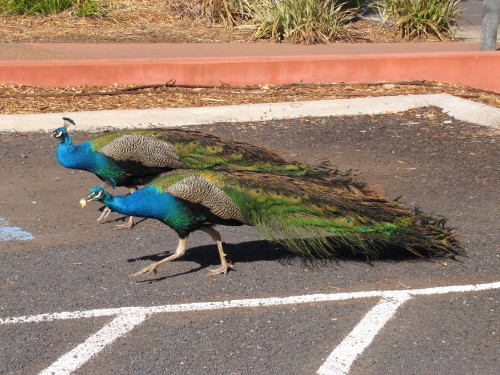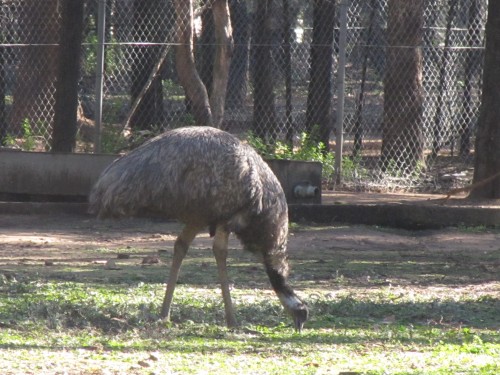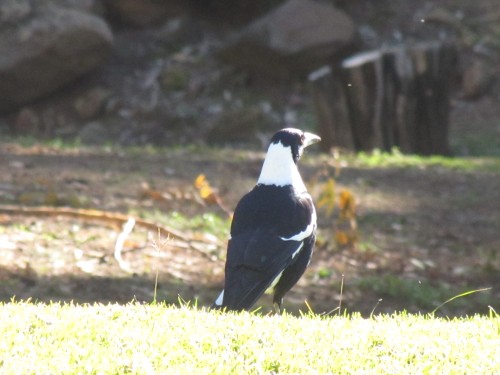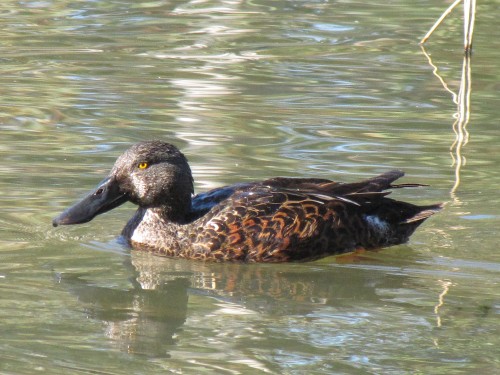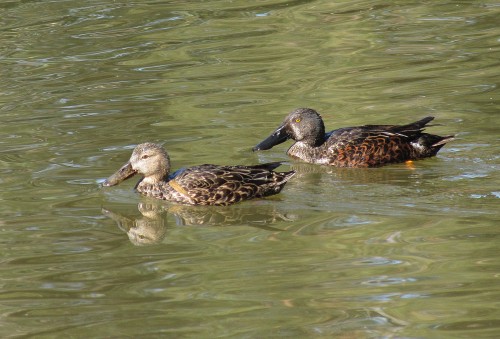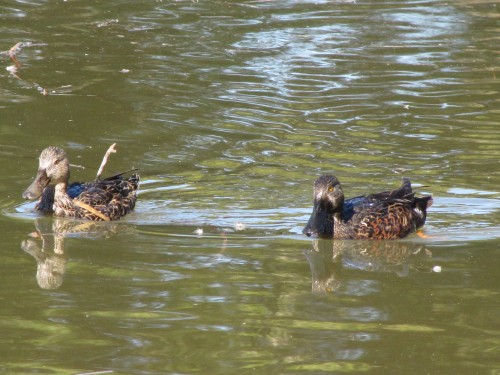Pink-eared Duck in Dubbo
One of the lovely features of the Western Plains Zoo in Dubbo, New South Wales, is the large artificial lake next to the visitor centre. I think it is wonderful that visitors can come to this part of the zoo without paying the entrance fee. This is particularly valuable to casual passers-by who do not have the time to spend a whole day in the zoo. (Two days are recommended to see everything and entrance fees are valid for two days.)
It is also great for local people who just want to have a picnic on the grassed area next to this lake. From the picnic area visitors get a good view of two exhibits: one with monkeys and another with lemurs. I will post photos of the lemurs in a few days.
The artificial lake featured in today’s post had a good range of water birds present. I am assuming that all of these birds are actually wild birds, and not a part of the zoo’s collection; a bonus add-on, if you like.
Featured in today’s photos is a Pink-eared duck, also known as a Zebra Duck because of the striped effect of the feathers. This species is a fairly common one in most of eastern Australia and much of Western Australia. It is rare in Tasmania and mostly absent from the drier interior. It is a highly nomadic species.
Peacocks at Dubbo
Over recent posts here I have featured some of the birds I saw on a visit to the Western Plains Zoo near Dubbo, New South Wales. As we were leaving several peacocks strutted past us in the car park – all for the world like they owned the place. I have found that this is a common trait in this species of bird.
I should give this bird it proper name: Indian Peafowl. Most people I know will call it a ‘peacock’, but that is more correctly the name given only to the male. The female is called a peahen. The birds shown in today’s post are all males.
This most colourful and charismatic of birds is an introduced species in Australia. The species is native to India and Sri Lanka. Small feral populations exist in many parts of the world, Australia being no exception. They are a common adornment in zoos, parks and gardens in many parts of Australia.
Further reading:
Emu at Dubbo Zoo
It is always good to see an Emu, one of Australia’s iconic birds while travelling around this wonderful country of ours. There have been many times when we have seen literally hundreds of these large birds in the one place. At other times we only see them singly, or in small loose flocks up to a dozen or so.
When travelling from home in Murray Bridge, South Australia to visit family in Sydney we are always on the lookout as we travel across the Hay Plains. Sometimes we see none at all; on other occasions we have seen hundreds, including many young birds following their father. (The male hatches the eggs and cares for the young for about their first 18 months of life.)
The bird in the photo above was a single individual on the side of the road we travelled through the open range zoo, the Western Plains Zoo at Dubbo in central New South Wales. I don’t know if this bird is a captive bird making up a part of the display of animals in the zoo, or if it is a wild bird that has adapted to the easy life inside the zoo perimeter. Whatever the situation, it was quite at ease in its environment and not at all concerned about our car driving along just a few metres away.
Black-backed Magpie at Dubbo Zoo
I am constantly intrigued by the huge variations in the plumage of Australian Magpies. As we travel from home in Murray Bridge, South Australia, I am always on the alert for all birds seen, and especially for the common magpie.
Here at home we have the White-backed race. As we travel eastwards towards Sydney – to visit family there – we encounter both White-backed and Black-backed as well as many hybrid variations. A few years ago we travelled from Sydney south along the coast, ending up at the home of friends north of Melbourne. Once again I observed many variations in plumage colours.
The photo above was taken as we drove through the Western Plains Zoo in Dubbo, New South Wales on a visit to the zoo last year. All of the magpies I observed in that region were of the Black-backed race, as are those I have seen in the Sydney area. If you have a field guide to Australian birds it may include a map showing the locations of various forms of this species (or at least a description of where they are found).
This should alert people interested in birds – even if it is just a passing interest – to closely observe even the common species. You never know what will come into your field of view.
Good birding.
Australasian Shoveler at Dubbo Zoo
On our visit last year to Dubbo Zoo in western New South Wales (Western Plains Zoo) we stopped to have lunch by a wetland next to the road which takes one through the zoo. On this swamp there were a few ducks, other waterbirds and many White Ibis, some nesting.
Two of the ducks in particular took my attention – a male and female Australasian Shoveler (also called Southern Shoveler). This is a species I have not seen very often and I only have a handful of photos worth showing here.
The Australasian Shoveler is found throughout the eastern parts of Australia, and is also present in south west Western Australia and in Tasmania. They are nomadic according to seasonal conditions and the presence of water. Their preferred habitats include lakes and other large bodies of water, either fresh or saline, swamps, wetlands, sewage ponds and flood waters.
While I concede that I haven’t observed this species on many occasions, in my experience they tend to be found singly, in pairs or small flocks, but never in great numbers. I stand to be corrected on this if I am wrong. This is also a rather timid species and is not easy to approach for photography. With the large number of daily visitors to the Dubbo Zoo is guess these birds have become used to people with cameras. I was able to get to within about 20 metres for these photos.
Further reading:
